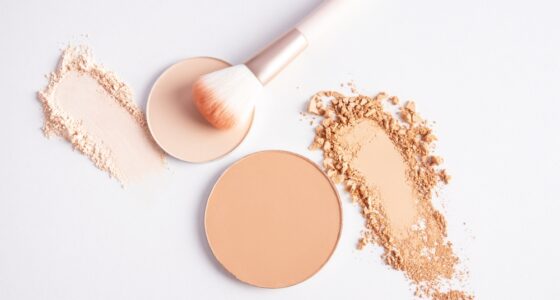When people think of asbestos, they picture high-heat or friction work settings and deteriorating insulation, not cosmetics. But in recent years, it’s come to light that the talc that is a core ingredient of makeup and personal products is frequently contaminated with the carcinogenic material, putting countless adults and children at risk for malignant mesothelioma and other serious health issues.

How Does Asbestos End up in Makeup?
Poor regulations led to asbestos getting into makeup through contaminated talc. Talc and asbestos are both natural minerals. Deposits of talc often include veins of asbestos. Commercial talc can be contaminated with this asbestos.
Talc is an insoluble clay mineral — the softest mineral on record. It is found worldwide and mined and processed for many products, including baby powder, makeup, pharmaceuticals, and more.
Though the general public associates talc with body powders that absorb moisture and odor when it comes to makeup, it is used as what is known as an expander. Talc is used to dilute pigment to deliver a desired cosmetic effect.
In the case of colored eye shadows, blushes, and facial powders, talc prevents color from becoming too intense. In other products, it improves the texture and feel.
Talc is also very water-absorbent, and as a result, it has been used for hundreds of years to prevent skin breakdown and inflammation. It absorbs oil and reduces shine.[1]
The cosmetic industry attempted to put controls in place to protect the public from asbestos-containing talc. The Cosmetic, Toiletry, and Fragrance Association (CTFA) put specifications in place in 1976 that specified cosmetic talc purity, including non-detection of asbestos.
But talc that is used for cosmetic purposes comes from the same mines as talc used for industrial applications.
The U.S. Food and Drug Administration has traditionally failed to require mandatory testing of talc supplies. Though the CTFA has put a voluntary asbestos testing method in place, the procedure that they use has been shown to have low sensitivity and specificity.[2]
As a result of this lack of oversight, many personal care products sold over the last several years have tested positive for asbestos.
According to a survey conducted by the Environmental Working Group, of more than 2000 personal care products, 57% are powder products that pose a risk of inhalation.
A transmission electron microscopy analysis conducted in 2020 revealed that 14 %, or 3 of 21 powder-based cosmetic products tested, were contaminated with amphibole asbestos. One of those products is marketed specifically for use by children.[2]
What Is the Risk of Asbestos in Makeup Products?
There has been a significant amount of attention paid recently to the risk of inhalation of talc-based body powders. The public is less aware of asbestos-contaminated makeup products or their dangers.
According to the scientists who conducted the survey, applying powder makeup to the face often results in the product being inhaled. When that product contains asbestos, the risk of malignant mesothelioma, asbestosis, lung and ovarian cancer, and other asbestos-related diseases is significant.[2]
Makeup Products Containing Asbestos
The U.S. FDA has recently advised consumers to stop using certain cosmetic products because product samples tested positive for asbestos. The best-known of these products is Johnson & Johnson’s Baby Powder, the discovery of which led to the company voluntarily recalling the product and later changing its formulation throughout North America.
But asbestos has been found in several other makeup products as well, including:[3]
- Beauty Plus Global Inc. City Color Collection Matte Blush (Fuchsia), SKU #849136008807, Lot No. 1605020/PD-840
- Beauty Plus Global Inc. City Color Cosmetics Timeless Beauty Palette, SKU #849136012958, Lot No. 1510068/PD-C864R
- Beauty Plus Global Inc. City Color Bronzer (Sunset), SKU #849136016017, Lot No. 160634/PD-P712M
- Beauty Plus Global Inc. Beauty Plus Global Inc. City Color Shimmer Bronzer (Caramel), SKU #849136017106, Lot No. 1612112/PD-840
- Beauty Plus Global Contour Effects Palette 2, Batch No. S1603002/PD-C1179
- Claire’s JoJo Siwa Makeup Set, SKU #888711136337, Batch/Lot No. S180109
- Claire’s Eye Shadows – Batch No/Lot No: 08/17
- Claire’s Compact Powder – Batch No/Lot No: 07/15
- Claire’s Contour Palette – Batch No/Lot No: 04/17
- Just Shine Shimmer Powder, Justice
- Claire’s Compact Powder style #83915-9
- Claire’s Contour Palette style #40194-3
- JoJo Siwa Makeup Set, Claire’s
- Mint Glitter Makeup Set, Claire’s
- Pink Glitter Palette with Eyeshadow & Lip Gloss, Claire’s
- Bedazzled Rainbow Heart Makeup Set, Claire’s
- Pink Glitter Cellphone Makeup Compact, Claire’s
- Professional Eye Makeup Kit, Claire’s
- Rainbow Bedazzled Star Makeup Set, Claire’s
- Rainbow Bedazzled Rectangle Makeup Set, Claire’s
- Ultimate Mega Makeup Set, Claire’s
- Metallic Hot Pink Glitter 48 Piece Makeup Set, Claire’s
- Rainbow Glitter Heart Shaped Makeup Set, Claire’s
Many of these products are marketed directly to children and teens and sold at popular mall stores.
Calls for FDA to Regulate Asbestos in Cosmetics
In response to a public outcry about asbestos in makeup products, the Biden administration passed the Modernization of Cosmetics Regulation Act (MoCRA) in December 2022. The law put into place requirements regarding adverse event reporting, ingredient disclosures, mandatory recalls, and safety substantiation.
Following the passage of the law, the FDA also set out to test for asbestos contamination in talc-containing cosmetic products in 2023.
Products tested were selected based on a variety of factors, including type of product, price, popularity, and whether the product was marketed to children or women of color. Still, health advocates say that more oversight is required, as well as more sensitive and accurate testing methods.[4]
How to Avoid Asbestos in Cosmetics
Because talc is still a permitted ingredient in cosmetic products, consumers who want to avoid the possibility of being exposed to asbestos are advised to stay away from makeup products that contain talc.
It’s important to remember that talc is a natural product, so looking for products that market themselves as organic or natural will not protect you from asbestos. Instead, search for products that specify that they do not contain talc.
To determine if a product contains talc, check the product label for the following ingredients:[5]
- Talc
- Talcum powder
- Magnesium silicate
Have You Been Exposed to Asbestos in Makeup Products?
Tens of thousands of consumers claim to have been sickened by asbestos-containing talc in body powder products made by Johnson & Johnson, Avon, and other well-known body powder companies.
Though they have gotten less attention, consumers have also filed lawsuits against several makeup companies accused of negligently exposing people to asbestos in their makeup.[6]
If you or someone you love has been diagnosed with an asbestos-related disease and you believe that your asbestos exposure came from asbestos-contaminated talc products, your best resource and source of information is an experienced asbestos attorney.
They can provide you with guidance about your rights. You may be eligible to file a personal injury lawsuit against those responsible.
References
- Knight, D. and Alessandrini, K. (2025, April 2). Is Talc in Makeup Bad for You? A Cosmetic Chemist Gives It to Us Straight. Byrdie.
Retrieved from: https://www.byrdie.com/is-talc-in-makeup-bad - Stoiber, T., Fitzgerald, S., and Leiba, N.S. (2020, November 24). Asbestos Contamination in Talc-Based Cosmetics: An Invisible Cancer Risk. Environ. Health Insights. 14:1178630220976558. doi: 10.1177/1178630220976558.
Retrieved from: https://pmc.ncbi.nlm.nih.gov/articles/PMC7691901/ - U.S. Food and Drug Administration. (2022, February 25). FDA Advises Consumers to Stop Using Certain Cosmetic Products.
Retrieved from: https://www.fda.gov/cosmetics/cosmetics-compliance-enforcement/fda-advises-consumers-stop-using-certain-cosmetic-products - U.S. Food and Drug Administration. (2024, December 31). Talc.
Retrieved from: https://www.fda.gov/cosmetics/cosmetic-ingredients/talc - Massachusetts Department of Public Health. (2019, June). Talc in Cosmetics & Consumer Products
Retrieved from: https://www.mass.gov/doc/talc-in-cosmetics-consumer-products/download - Brown, R. (2024, April 10.). Ben Nye Files Chapter 11 Bankruptcy Talc Lawsuits. Beauty Independent.
Retrieved from: https://www.beautyindependent.com/ben-nye-files-chapter-11-bankruptcy-talc-lawsuits/

Terri Heimann Oppenheimer
WriterTerri Oppenheimer has been writing about mesothelioma and asbestos topics for over ten years. She has a degree in English from the College of William and Mary. Terri’s experience as the head writer of our Mesothelioma.net news blog gives her a wealth of knowledge which she brings to all Mesothelioma.net articles she authors.

Dave Foster
Page EditorDave has been a mesothelioma Patient Advocate for over 10 years. He consistently attends all major national and international mesothelioma meetings. In doing so, he is able to stay on top of the latest treatments, clinical trials, and research results. He also personally meets with mesothelioma patients and their families and connects them with the best medical specialists and legal representatives available.


